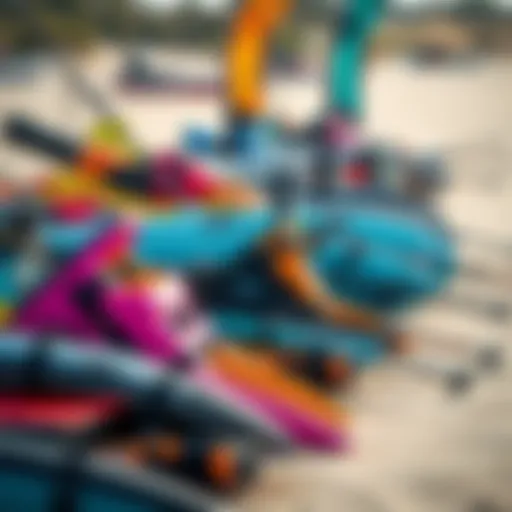Exploring Pro Kitesurfing: Skills, Culture, and Trends
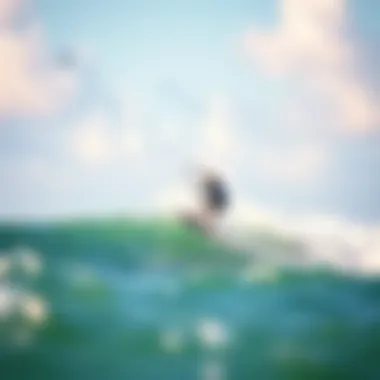
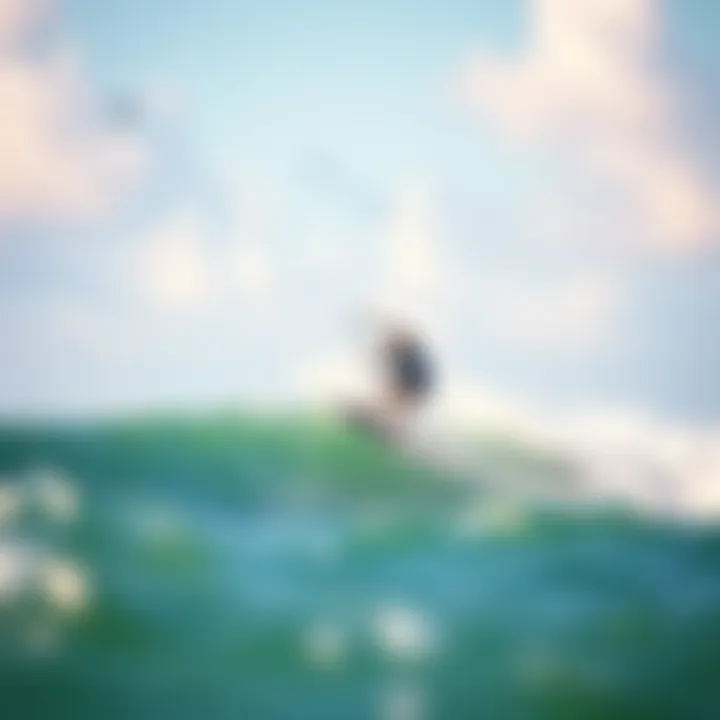
Intro
Kiteboarding, often regarded as the thrill-seeker's playground, intricately blends the art of surfing with the science of kite flying. For enthusiasts, this sport is not just about riding the waves; it's a journey through dexterity and understanding nature's whims. A deep dive into prokitesurfing reveals a landscape where personal skill meets technological advances and cultural rituals. It’s about harnessing the power of the wind while navigating through intricate techniques and safety practices.
As we embark on this exploration, the foundation of understanding prokitesurfing begins with gear. Selecting the right equipment is a cornerstone of both zenith performance and enjoyment. There’s no one-size-fits-all; each individual may require different gear tailored to their preferences and environment.
The narrative will further unfold to cover not just gear, but also essential tricks that can elevate one’s capability on the water. Safety is paramount, as the ocean is as unforgiving as it is beautiful, so it's vital that our community embraces best practices and adheres to safety standards.
Throughout our voyage, we will gauge emerging trends that shape the sport today—from materials used in kites to burgeoning travel destinations that appeal to kiteboarding aficionados. As we thread these elements together, the aim is to provide a rich tapestry of knowledge, weaving insights that are both engaging and enlightening for all levels of kiteboarders—from novice to seasoned pros.
It’s time to delve in, explore the intricate layers of prokitesurfing, and perhaps find inspiration or tips that might just transform your next session out on the water.
Preface to ProKiteSurfing
In the realm of extreme sports, kitesurfing has managed to carve out its own unique niche, capturing the hearts of thrill-seekers and wanderers alike. This phenomenon, often dubbed prokitesurfing, offers both an adrenaline rush and profound tranquility, as athletes harness the wind and water in an elegant ballet of skill and nature. Understanding the essence of prokitesurfing, its tools, and its history is paramount for anyone looking to delve deeper into the sport.
Understanding ProKiteSurfing
Prokitesurfing is not merely about riding waves with a colorful kite overhead; it’s an intricate dance that combines elements of surf, wind navigation, and athletic prowess. In essence, kitesurfing requires mastering various techniques, from controlling the kite’s flight to selecting the right equipment for specific wind conditions.
An appealing aspect of kitesurfing is its accessibility—regardless of one’s background, anyone can take to the waters, learn the fundamentals, and progress into more advanced maneuvers. The importance of understanding the foundational principles, such as wind theory and safety practices, cannot be overstated. They are the bedrock upon which all skills are built, enabling enthusiasts to develop their prowess confidently.
For beginners, grasping the nuances of kite control can feel like juggling flaming swords. Yet, with guidance and practice, one can connect with the elements in ways that are both freeing and exhilarating. As skills advance, riders often explore diverse styles and tricks, each adding a layer of complexity to their overall understanding of the sport.
Historical Context of Kitesurfing
The roots of kitesurfing extend deep into both ancient and modern history, drawing connections back to centuries-old kite-flying traditions in Asia. The first modern kitesurfing prototypes can be traced to the late 1980s, with pioneers like Brendon Theobald and others experimenting with kite designs and surfboards.
As kitesurfing evolved from these humble beginnings, it gained traction worldwide, particularly in the 1990s and early 2000s. It was during this period that various brands, such as Naish and Cabrinha, played significant roles in developing the sport. Innovations in kite technology and materials made the sport more accessible and enjoyable, spawning a devoted community of enthusiasts.
"Kitesurfing is a blend of finesse and force; understanding its past contextualizes its future."
Culturally, kitesurfing has also fostered a collaborative spirit among riders. Annual gatherings and competitions take the sport to new heights, contributing to a sense of belonging within the community. In many coastal areas, local kitesurfers operate schools, sharing knowledge and skills with newcomers, cultivating the sport in their regions.
Technical Aspects of ProKiteSurfing
When diving into prokitesurfing, one can't overlook the technical aspects; they are the backbone of this exhilarating sport. The equipment choices, techniques employed, and safety measures are not merely optional details, but foundational elements that can make or break one’s experience on the waves. Understanding these aspects can enhance not only performance but also safety and enjoyment, making it essential for both novices and seasoned practitioners.
Equipment Overview
The equipment used in kitesurfing is critical for optimal performance. Let's explore the vital components that every kiteboarder should know about.
Types of Kites
The types of kites available may seem varied at first glance, but choosing the right kite can drastically affect performance. Most commonly, you'll encounter inflatable kites and foil kites. Inflatable kites, known for their structure and stability, are typically favored by beginners due to their ease of control. These kites, equipped with air chambers, tend to float well and are comparatively safer for those starting out.
On the other hand, foil kites, lacking a rigid frame, offer greater maneuverability and are often preferred by advanced riders who seek high performance. Their unique structure allows riders to maximize wind efficiency. However, they can be less forgiving in turbulent conditions. In short, the type of kite you opt for can influence your ride's dynamics and safety, contributing to an enjoyable kitesurfing experience.
Kiteboards and Their Varieties
Kiteboards come in various forms, which serve distinct riding styles and preferences. The primary types to consider are twin tips and directional boards. Twin tips, which allow for riding switch (i.e., with either foot forward), are perfect for general kitesurfing and are highly popular among beginners and intermediate riders alike. This versatility is crucial for learning new tricks.
On the flip side, directional boards cater to surfing-style kitesurfing. They offer more of a surfboard feel, ideal for those who enjoy riding waves. Pick wisely between these options, as they can dictate how you engage with water and wind, steering your experience toward either freestyle or wave riding.
Safety Gear Essentials
Nothing is more important than safety while indulging in kite sports. Proper safety gear is a must for any kiteboarder, whether you’re a newbie or a seasoned pro. Essential items include a well-fitted helmet, impact vest, and harness. The helmet protects your noggin in case of unexpected tumbles, while the impact vest absorbs shocks during hard landings. A good harness keeps you securely attached to the kite, allowing for better control without excessive strain on your body.
Don’t overlook the release mechanism and leash – they’re lifesavers when quick action is needed. Understanding and utilizing the correct safety gear will ensure that you’re more focused on riding and less on potential hazards.
Techniques for Improvement
The journey of learning techniques in prokitesurfing can be daunting, yet it is equally rewarding when properly grasped. These techniques range from fundamental skills for beginners to advanced maneuvers that can define a practitioner's style.
Basic Skills for Beginners
Focusing on basic skills for beginners is essential as they lay the groundwork for more advanced techniques. The ability to control the kite, understand wind direction, and perform simple maneuvers like body dragging and water starts are crucial. A solid foundation empowers you to become more confident on the water.
Starting with these core skills helps prevent frustration and injury and sets a comfortable pace for improving your riding style. It’s the stepping stone toward becoming a proficient kiteboarder, influencing the way you'll interact with wind and water.
Advanced Maneuvers Explained
For those eager to take their skills to the next level, understanding advanced maneuvers is where the thrill begins. Tricks like jumps, flips, and complex rotations enliven the kitesurfing experience, showcasing one’s mastery over the sport. Learning these stunts requires not just practice but a deep understanding of kite control and body positioning.
This segment of training pushes both physical limits and mental boundaries, offering a rewarding experience. Mastering your craft through innovation in maneuvers significantly enriches your time spent on the water, making it unforgettable.
Troubleshooting Common Issues
Troubleshooting common issues is an unavoidable part of the kitesurfing journey. Whether it’s tangled lines or kite equipment issues, knowing how to address these challenges quickly and effectively makes a significant difference.


Riders must learn basic repairs and how to read the conditions around them. The unique element here is that handling such mishaps smoothly can lead to safer rides and improved confidence. Knowledge in troubleshooting can prevent small problems from becoming big obstacles, ensuring the focus remains on the joy of kitesurfing.
Remember, the essence of kitesurfing lies not just in mastering moves but also in embracing the learning journey.
This section wraps up the technical discourse about prokitesurfing, underscoring the importance of equipment and technique. As kiteboarders travel down this path, it becomes clear that technical knowledge enhances both safety and skill, ultimately resulting in a more satisfying experience on the water.
Environmental Considerations
Environmental considerations play a pivotal role in enhancing the experience of pro kite surfing. Not only do they influence the performance and safety of kiteboarders, but they also dictate the sustainability practices that can enrich the sport for future generations. Understanding these elements can lead to better decision-making when hitting the waves, which in turn fosters a responsible and enjoyable atmosphere in this thrilling sport.
Wind Patterns and Conditions
The wind is a kiteboarder's best friend, and understanding its patterns is crucial for anyone looking to excel in pro kite surfing. Wind speed and direction can greatly affect not just the ride, but also the safety of the experience.
Many seasoned kiteboarders swear by utilizing local weather apps or coastal wind maps to gauge conditions before heading out. These tools provide essential wind forecasts, helping adventurers pick the right time to set sail.
A good rule of thumb is to look for winds between 12-25 knots for recreational surfing. Anything below can be lackluster, and anything above can quickly escalate into perilous territory.
Water Conditions and Locations
Finding the Right Spot
Finding the right spot to kite surf is an art in itself. Not every beach or waterway is created equal, and choosing the right location can enhance your experience immensely. Look for areas with clean, unobstructed wind and sufficient space for take-off and landing. Think about spots where local kiteboarding communities gather, as they often know the ins and outs of the conditions there.
A large sandy beach with flat water is ideal for beginners, while advanced kiteboarders might seek out spots with challenging waves for that adrenaline rush. Some kiteboarders enjoy practicing their skills in places like the Tuxai Lagoon in Brazil or the thrilling wave breaks of Cape Town, South Africa.
Seasonal Variations
The seasons also have significant implications for kiteboarders. Different times of the year bring varying weather patterns, which affect the wind and water conditions. For example, summer months may provide consistent trade winds in some tropical locations, while winter can gift areas with storm systems that create powerful waves.
Knowing the seasons allows kiteboarders to plan their trips accordingly, ensuring access to the best conditions. Don’t forget to pack extra layers for colder months, as temperatures can differ significantly.
Safety in Different Environments
Safety is paramount when engaging in pro kite surfing, and recognizing the features of each environment can make a world of difference. Whether you're in shallow waters or surfing a picturesque beach, familiarity with local hazards—like rocks, reefs, or even wildlife—can ensure a safer experience.
In addition to environmental awareness, kiteboarders should adhere to local regulations that may dictate specific areas for kiteboarding. The quite critical aspect of safety gear, such as helmets and impact vests, should also never be overlooked.
"Finding the right spot, understanding seasonal variations, and practicing safety in diverse environments not only ensures a more enjoyable ride but also promotes responsibility within the kiteboarding community."
Embracing these environmental considerations enriches the kiteboarding experience, fostering a deep connection with nature while ensuring safety and sustainability for future kiteboarders.
Kiteboarding Communities
Kiteboarding communities play an essential role in the realm of prokitesurfing, fostering camaraderie and shared passion among enthusiasts. Connecting fellow kiteboarders can lead to skill enhancement, exploration of new locations, and a deeper understanding of the sport's culture. Engaging with these communities provides a platform for sharing experiences, learning from each other, and celebrating the diverse aspects of kiteboarding. The importance of these connections resonates through various elements, including cultural significance, local contributions, events, and competitions.
Global Kitesurfing Culture
Cultural Significance in Various Regions
The cultural significance of kitesurfing varies markedly across different regions of the globe. In many coastal towns, kiteboarding isn't just a sport but a cultural identifier. For instance, places like Tarifa in Spain have become synonymous with the sport, attracting enthusiasts from all walks of life. Here, the wind and waves create a vibrant atmosphere where locals and travelers exchange tips and tricks. This cultural blend cultivates a sense of belonging, around a shared love for thrill and adventure.
A key characteristic of these regions is the strong community spirit that embraces both skilled riders and newcomers. While this can be a beneficial aspect, fostering an inviting environment, the saturation of beautiful beaches can sometimes lead to overcrowding.
Local Communities and Their Contributions
Local kiteboarding communities contribute significantly to the atmosphere of camaraderie. They offer invaluable mentorship to beginners and organize meetups, creating a supportive network. Through lessons, local competitions, and group excursions, these communities help novices gain confidence and skills in a friendly environment.
One unique feature is the sense of local pride, which fosters sustainable practices as individuals become more mindful of their environment. However, challenges may arise, such as differing skill levels leading to discomfort during group practices.
Events and Competitions
Events and competitions in the kitesurfing arena serve as significant gatherings for kiteboarding enthusiasts. Competitions not only showcase skill and talent but also create a buzz around the sport, boosting local economies through tourism. Events like the World Kiteboarding League in Cape Town or the GKA Kite World Tour attract professional athletes and spectators alike, strengthening the kiteboarding community.
These events are a highlight for many riders, offering a chance to witness top-tier skills and meet likeminded individuals. However, the intense pressure of competitions might deter some casual kiteboarders, as the focus shifts from pure enjoyment to performance.
Engaging with Fellow Kiteboarders
Building a Network
Building a robust network within the kiteboarding community opens up numerous opportunities. Knowing the right people can lead to discovering secret spots and enhancing your skills through shared knowledge. Personal connections create a nurturing environment where ideas and experiences flow freely.
The key here is that a good network can span geographically; kiteboarders often travel and connect with others, enriching their knowledge and perspectives.
Connection through Online Platforms
Digital platforms have gained enormous importance in the kiteboarding community. Websites and social media groups allow kiteboarders to share their experiences, ask questions, and learn from others around the globe. Engaging in these digital spaces can facilitate fast connections and provide accessibility to resources, even for those starting in remote areas.
While online platforms create opportunities to connect, they can sometimes dilute the personal touch necessary for deeper relationships.
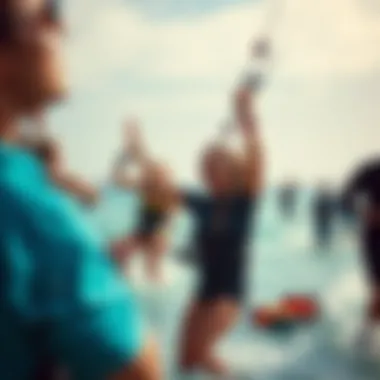
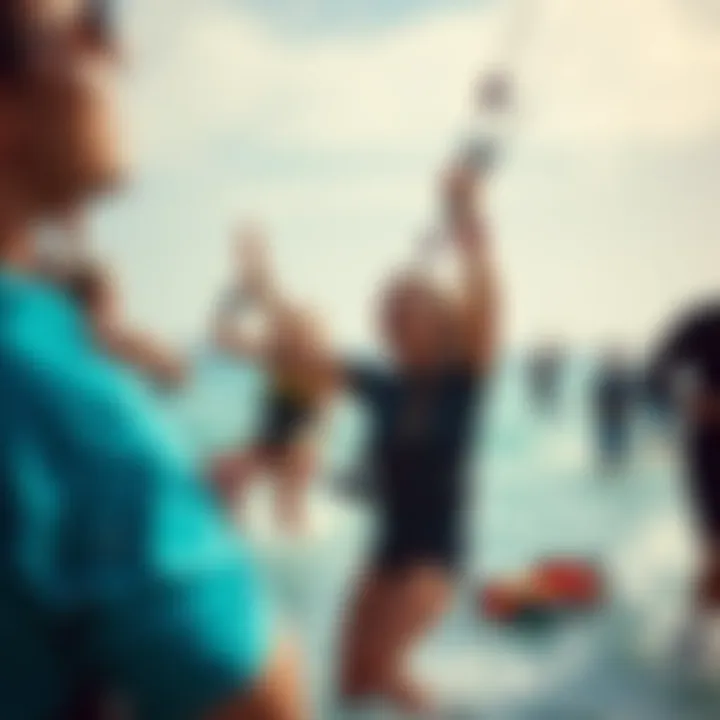
Sharing Experiences and Knowledge
Sharing experiences and knowledge is at the heart of what binds kiteboarders together. This sharing can manifest through tutorials, written blogs, or informal meetups. More experienced riders often take the initiative to coach newcomers, thus enhancing their skills while promoting a culture of mentorship and encouragement.
Such practices also inspire others and push the boundaries of kiteboarding techniques. However, it’s crucial to ensure that sharing is constructive and tailored to individual skill levels to maintain and grow interest in the sport.
Traveling for KiteSurfing
Traveling is an integral part of the kitesurfing experience. For kiteboarders, it’s not simply about the thrill of gliding over waves; it’s also about exploring new horizons. The sport brings you to various destinations, each offering unique weather conditions and landscapes. When you venture out, you open yourself to a multitude of experiences, enrich your skills and, ultimately, deepen your love for this exhilarating activity.
Top Destinations Worldwide
Exploring the vast array of locations available for kitesurfing can significantly enhance one’s proficiency on the board. Different spots cater to various skill levels and preferences, from serene lagoons to turbulent coastlines. Here, we break down some noteworthy categories.
Hidden Gems for Adventurers
Venturing off the beaten path often leads to unexpected treasures. For instance, La Ventana in Mexico is a lesser-known paradise for kiteboarders seeking untouched beauty. The strikingly clear waters and consistent winds make it a coveted choice, and here, you can kite without the crowded beaches seen in mainstream locations.
A unique aspect of hidden gems is the promise of solitude, which can be particularly appealing for those wanting to hone their skills away from prying eyes. However, travelers should be cautious as these spots might lack immediate emergency resources.
- Key Characteristics: Uncrowded, serene, often pristine.
- Benefits: Peaceful surroundings allow for focused practice.
- Drawbacks: Limited access to services such as lessons and repairs.
Popular Travel Spots
Anticipating a trip to a renowned kitesurfing haven like Tarifa in Spain brings a different kind of excitement. Known as the wind capital of Europe, it attracts thousands of enthusiasts yearly. Tarifa offers a lively atmosphere combined with various conditions catering to all skill levels. Here, spots like Playa de Los Lances give you reliable winds and ample space.
However, with popularity comes the challenge of overcrowding. Moreover, high foot traffic can sometimes lead to a less personal experience. It’s essential to be prepared for a bustling environment, and renting gear can be a practical option rather than hauling equipment.
- Key Characteristics: Vibrant culture, close proximity to amenities.
- Benefits: Abundant resources for beginners and advanced riders alike.
- Drawbacks: May become overly crowded during peak seasons.
Local Kiteboarding Instructors
When traveling, connecting with local kiteboarding instructors can amplify your experience. They not only offer technical skills training tailored to the local conditions but also enhance your understanding of the unique attributes of each spot. For instance, working with local experts at locations like Cabarete in the Dominican Republic can expose you to techniques specialized for the local winds and waves.
Engaging with instructors also provides access to lesser-known spots and hidden tricks of the trade that can only be gleaned through their experiences. The investment in local instruction, however, can be a bit pricier than anticipated, so budgeting wisely is crucial.
- Key Characteristics: Local knowledge, tailored training.
- Benefits: Improved skills and awareness of local conditions.
- Drawbacks: Higher costs can extend travel budgets.
Planning Your Kiteboarding Trip
Once you’ve decided on your travel destination, careful planning is critical to ensuring a smooth trip. Identifying what’s essential can help you maximize your time on the water.
Key Considerations
As a kitesurfer, considering the wind patterns, seasonal changes, and water temperatures of your chosen location is vital. Furthermore, checking the local regulations regarding kitesurfing is equally important. Some beaches may have restrictions that can impact your trip.
- Characteristics: Environmental factors, regulations, community norms.
- Benefits: Tailored experiences based on season and local guidelines.
- Drawbacks: Missteps in planning could lead to frustrating surprises.
Travel Insurance for Kitesurfers
Purchasing travel insurance specifically designed for kitesurfers ensures peace of mind. Many policies offer tailored coverage, including gear protection and emergency evacuation, which regular travel insurance neglects. It can be a lifesaver if something goes awry while enjoying your sport abroad.
- Characteristics: Specific coverage for kitesurfers.
- Benefits: Protection against gear loss or accidents.
- Drawbacks: Might cost more than standard travel insurance plans.
Packing Essentials
Assembling a comprehensive packing list is a must. Consider including items such as your kite gear, appropriate clothing, repair kits, and any safety gear. Being organized means you’ll have everything you need at hand, allowing you to focus on what truly matters: the water and your experience.
- Characteristics: Gear specifics, personal items, essentials for a kitesurfing trip.
- Benefits: Ensures all necessary equipment is on hand.
- Drawbacks: Overpacking could lead to unnecessary burdens.
"A well-planned trip can be the difference between a hectic experience and an unforgettable adventure in the world of kitesurfing."
Safety in ProKiteSurfing
Safety is the cornerstone of an exhilarating yet challenging sport like prokitesurfing. Whether you're a novice or a seasoned kiteboarder, the significance of awareness and precaution cannot be overstated. Understanding safety not only enhances your enjoyment but also helps prevent unnecessary injuries or accidents. The essence of safety in kitesurfing lies in a blend of risk management, preparedness, and community engagement.
Risk Management Basics
Understanding Potential Hazards
One could argue that recognizing potential hazards is much like spotting a shark in the water; it's crucial but often overlooked. Kiteboarders face various risks, from sudden changes in wind conditions to dangerous water currents. By understanding these hazards, kiteboarders are more empowered to make informed decisions on the water.
Key characteristics of this understanding include awareness of local conditions and regular assessments before each session. Undesirable weather can turn a fun day kiteboarding into a treacherous situation. Additionally, spotting fellow riders in distress could be a lifesaver.
The unique feature of grappling with these hazards is the prerequisite for education and preparation. This proactive approach avoids the pitfalls and ensures a safer experience for everyone involved. However, the downside is that not every rider invests the time needed to study these conditions, sometimes leading to recklessness.
Basic Safety Protocols
When it comes to basic safety protocols, it's the small things that save lives. Familiarizing oneself with equipment checks and the buddy system can be beneficial for every kitesurfer. Ensuring your gear is in good condition and communicating signals with fellow riders creates a safe environment.
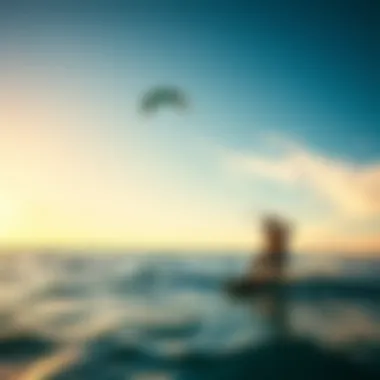
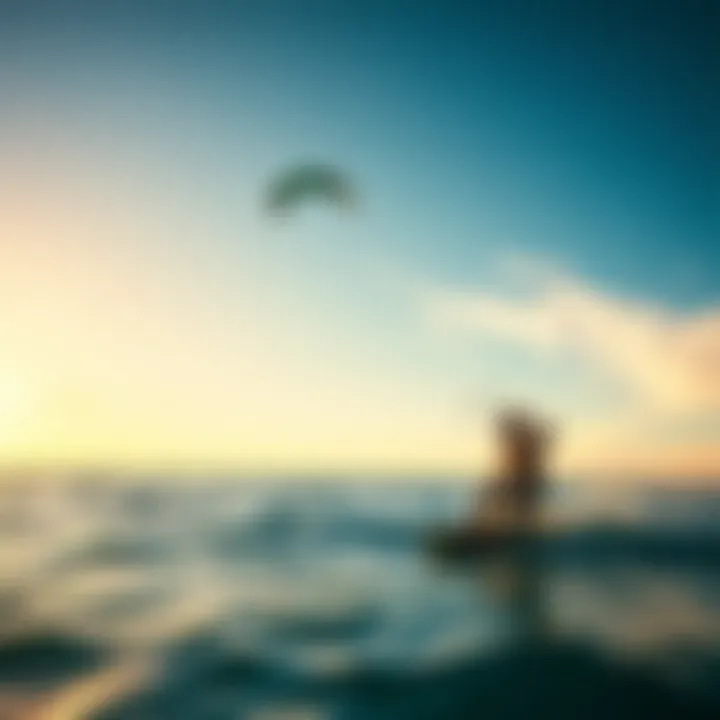
Such protocols are grounded in common sense, yet they are often neglected due to overconfidence, especially among experienced riders. A regular checklist for safety checks, including verifying harness connections and kite lines, is invaluable.
The unique benefit of these protocols is that they are easily adoptable but demand diligence and commitment. Ignoring them can have serious consequences, as they are often the first line of defense against hazards.
Emergency Response Strategies
Emergency response strategies represent the essential plan of action when things go awry. Being prepared is half the battle, and kiteboarders who understand how to act during an emergency are more likely to ride another day.
Such strategies generally include knowing when and how to call for help, recognizing signs of distress in others, and basic rescues. This knowledge not only safeguards the individual rider but also enhances the overall community safety culture.
A defining aspect of these strategies is the crucial countdown clock – time is of the essence in emergencies. A well-thought-out response is quicker than improvising under pressure. While the importance of preparation is clear, failure to rehearse these techniques can lead to fatal delays when every second counts.
First Aid and Precautions
First Aid Kit Essentials
No kiteboarder should hit the waves without a well-stocked first aid kit. The essentials of such a kit often include adhesive bandages, antiseptic wipes, and various sizes of gauze. The inclusion of items tailored to kiteboarding such as waterproof plasters adds an extra layer of practicality.
Key characteristics of a first aid kit are versatility and accessibility. It's not just about having a kit but also knowing how to use it effectively. A comprehensive kit serves as a safety net that every rider can rely upon.
The unique feature here is the peace of mind it offers knowing you’re prepared for minor injuries, which can greatly improve your confidence while riding. However, a flaw lies in the tendency to overlook restocking after use, leading to a false sense of security.
Recognizing and Treating Common Injuries
Another aspect of safety involves recognizing and treating common injuries. Injuries can range from abrasions to sprains or even more severe conditions like hypothermia due to prolonged exposure in cold water. Knowing these injuries and their treatments allows riders to act quickly when necessary.
The benefit of this knowledge is that it not only aids the affected individual but can also lead to better outcomes for all participants. Sharing such knowledge in a community setting reinforces collective safety. But, as always, without directed learning, there’s a risk of ignoring critical signs that can escalate into severe conditions.
Prevention Techniques
Prevention techniques cover a broad range of activities aimed at mitigating risks before they manifest into problems. This can include skill development and practicing maneuvers in controlled environments before tackling harsher conditions. Maintaining physical fitness is also a preventive measure that enhances resiliency on the water.
Key characteristics of these techniques include the importance of formal education and ongoing support from experienced kiteboarders. They provide a practical framework for newcomers to learn from seasoned riders, essentially spreading knowledge like wildfire. The downside, however, is that there may be a learning curve that not everyone is willing to navigate.
Future Trends in ProKiteSurfing
The landscape of prokitesurfing is constantly evolving, influenced by innovations in equipment, shifts in techniques, and larger social trends. Keeping an eye on future developments is crucial for both novices and seasoned riders, as these trends can greatly enhance the overall experience of the sport and lead to safer practices as well. In this section, we will explore key innovations, the influence of technology, and the community's adaptation to changing environments that shape the future of kitesurfing.
Innovations in Equipment
Advancements in Kite Design
The design of kites has come a long way, and that's no exaggeration. Gone are the days of simple, one-size-fits-all kites. Today, advancements in kite design focus on maximizing performance, control, and ease of use. For instance, brands like Naish and Cabrinha have begun incorporating features like reflex profiles, which enhance lift and improve turning speed. This allows riders to perform complex maneuvers with greater ease.
A key characteristic of these new designs is their versatility, allowing them to be effective in various wind conditions—whether you’re facing a light breeze or strong gusts. However, while these advancements improve performance, they require a steeper learning curve, especially for beginners who may find it challenging to adapt quickly to such responsive kites.
Breakthroughs in Materials
Materials technology has made significant strides, leading to the creation of lighter, stronger, and more durable kites. Manufacturers now utilize materials like ripstop nylon and advanced composites that not only reduce the weight of kites but also enhance their durability against wear and tear. A unique feature of these new materials is their resistance to UV light, which prevents degradation over time—a common issue experienced in older models. Such advancements are instrumental in extending the lifespan of kites, providing a better return on investment. However, it’s important to note that while these materials are cutting-edge, they can sometimes come with a higher price tag, potentially limiting accessibility for those just starting out.
Sustainability Practices
As awareness regarding environmental issues increases, sustainability practices in kitesurfing are gaining traction. Manufacturers are now exploring eco-friendly materials and production processes to reduce their carbon footprint. Kite brands such as Ozone are leading the charge, using recyclable materials in their products. This approach not only appeals to environmentally-conscious consumers but also sets a precedent for responsible manufacturing in the action sports industry. A distinct characteristic of sustainable practices is the emphasis on minimal waste and long-lasting products, which ultimately benefits both the sport and the planet. However, as the demand for sustainable options grows, it’s important to ensure these practices are not just marketing strategies but are genuinely contributing to environmental stewardship.
Evolving Techniques and Styles
New Tricks and Skills
As kitesurfing evolves, so do the tricks and techniques. Riders continually push the boundaries, experimenting with new moves that require greater skill and coordination. Tricks such as the double handle pass or the megaloop are becoming more common, reflecting a trend towards increasing aerial maneuvers and more complex sequences. The key characteristic of these new skills is their reliance on improved kite technology, which allows riders to execute them safely and effectively. While mastering these new tricks can elevate one’s style and contribute to making a name in the community, they also increase the risk involved in the sport, necessitating a solid foundation in basic techniques before advancing.
Impact of Technology on Performance
Technology is reshaping the way riders approach their craft. Data analytics, through smart sensors and telemetry, allows kiteboarders to analyze their performance metrics like never before. This insight enables personalized training regimens, helping riders focus on specific areas for improvement. A significant aspect of this technological impact is the ability to track performance over time and set tangible goals. However, this can lead to a reliance on data rather than instinct, which can detract from the natural enjoyment of the sport if not balanced appropriately.
Adaptation to Changing Environments
Riders today must adapt to diverse conditions, from shifting wind patterns to varying water obstacles. The ability to read the environment and adjust one’s techniques accordingly is more vital than ever. This adaptability is not just about skill but also involves knowing when to take a break or change locations based on environmental safety. The uniqueness of this adaptive skill set lies in its practice; it not only enhances riding skills but also fosters a deeper connection with nature. However, it can be a double-edged sword as changing weather conditions can pose serious risks if mishandled. Knowledge and experience become the most reliable tools in a kitesurfer’s kit.
In sum, keeping abreast of these trends in prokitesurfing is essential for anyone looking to deepen their involvement in the sport. By understanding advancements in equipment, evolving techniques, and the broader environment, riders can anticipate challenges and leverage opportunities to elevate their kitesurfing experiences.
The End
Summarizing Key Insights
In this exploration of prokitesurfing, we have ventured through the rich tapestry of this thrilling sport, unraveling its technical aspects, cultural influences, and future outlook. The journey began with a deep dive into the foundations of prokitesurfing, showcasing how the sport has evolved over the years, from a niche water activity to a globally recognized phenomenon. We examined how the right equipment plays a crucial role, from the types of kites to various kiteboards, underlining the importance of selecting gear that matches one's skill level and style.
Wind and water conditions were discussed, highlighting how they can change the dynamics of kitesurfing. Understanding environmental factors isn't just an academic exercise; it has direct relevance to safety and performance while out on the water.
The strong sense of community that characterizes kitesurfing was also a focal point. Engaging with local and global communities can elevate the kitesurfing experience significantly. Connections made through forums, local meetups, and competitions enrich both knowledge and enjoyment.
Lastly, the article addressed the pressing future trends, showcasing how innovations in material science and design are setting the stage for better performance and sustainability. The kitesurfing landscape is shifting, and those who stay updated are bound to reap the rewards. The insights and knowledge amassed here are essential for both novices eager to start and seasoned riders looking to refine their craft.
Call to Action for Enthusiasts
Now is the time to take your kitesurfing experience to the next level. Don’t let this be just another interesting read; take action.
- Engage with your local kitesurfing community. Many cities have clubs or meetups. Find one near you.
- Join online platforms, like Reddit's r/Kitesurfing or specific Facebook groups, where you can share tips and learn from others’ journeys.
- Experiment with new techniques discussed in this article. Challenge yourself with a new trick, or simply practice in varying conditions to gain confidence.
- Stay informed about the latest gear—check websites like www.britannica.com or www.kiteforum.com to read reviews and insights on new equipment.
- Plan a trip to one of the top destinations mentioned earlier. Sometimes, a change of scenery can spark inspiration and enhance skills.
With kite in hand and wind at your back, the horizon is wide open—seize it!















